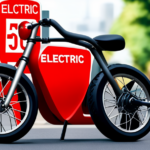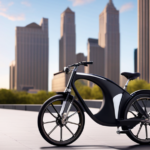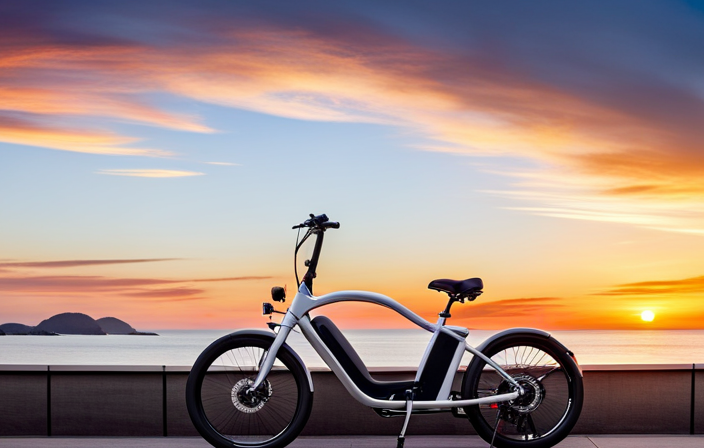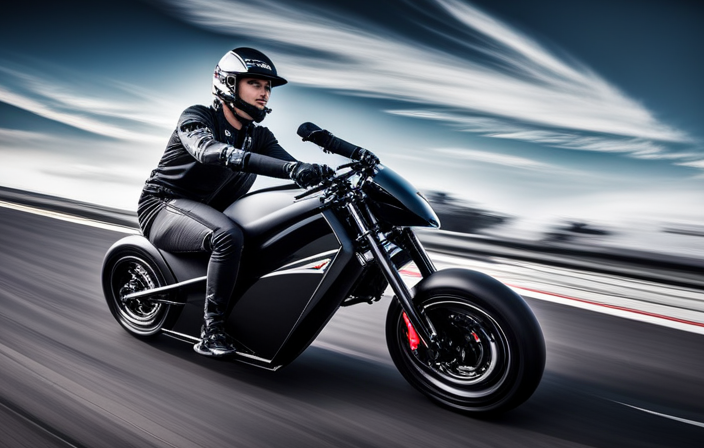To ride an e‑bike legally in Europe, you need to follow local rules based on e‑bike classification, speed, power, and age restrictions. Standard e‑bikes with support up to 25 km/h typically don’t require registration or insurance, but high-speed or powerful models often do. Helmet laws, permitted areas, and licensing vary by country. Staying compliant guarantees safe riding and avoids penalties. To understand specific rules for your region, there are important details you’ll want to explore further.
Key Takeaways
- E-bikes are classified into categories like pedelecs (up to 25 km/h, 250W) and speed pedelecs (up to 45 km/h), with different legal requirements.
- Standard e-bikes typically do not require registration, insurance, or licensing, but high-powered models do.
- Helmet use is mandatory for speed pedelecs and recommended for standard e-bikes, varying by country and rider age.
- E-bike usage on bike lanes or paths depends on local regulations and compliance with speed and power limits.
- Enforcement includes roadside checks, penalties for violations, and potential license suspension for safety or legal infringements.
Overview of European E-Bike Classifications and Standards
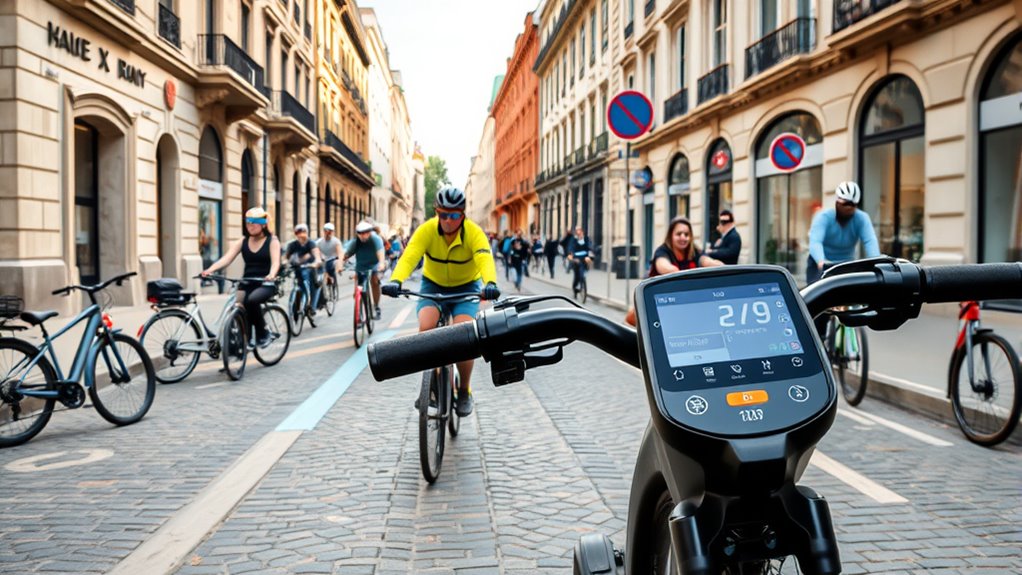
In Europe, e-bikes are categorized into distinct classes based on their motor power and maximum speed, which determine their legal status and the requirements for riders. The EU standards define e-bike classifications such as pedelecs and Speed Pedelecs, each with specific regulations. Pedelecs are powered solely by pedal assistance, with motor power limited to 250W and a speed limit of 25 km/h, making them treatable as bicycles. Speed Pedelecs, on the other hand, can reach speeds up to 45 km/h and are classified as mopeds, often requiring registration, insurance, and licenses. These classifications comply with EU standards like EN15194 and regulations such as the European Machinery Directive, ensuring safety and harmonized standards across member states. Additionally, safety standards are crucial for ensuring rider protection and vehicle reliability across different countries. As the popularity of electric mobility increases, ongoing updates to legislation aim to address emerging technologies and ensure consistent safety measures.
Key EU Regulations Governing E-Bike Power and Speed Limits
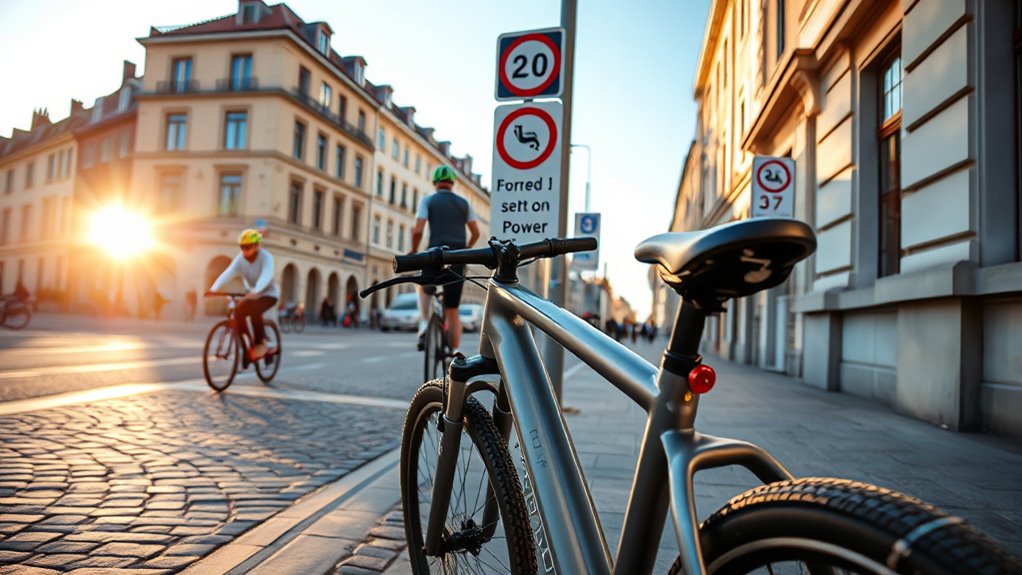
EU regulations limit e-bike motors to 250W to classify them as bicycles, and assistance must stop once you reach 25 km/h. Speed Pedelecs can go faster and have more powerful motors but are treated as mopeds, requiring registration. These rules guarantee safety and consistency across all member states. Additionally, there is an increasing adoption of mobile apps for ordering, which has increased consumer convenience and streamlined service options. Implementing financial management strategies such as proper budgeting helps ensure compliance with regulations while maintaining operational efficiency. Regularly assessing and organizing your e-bike accessories can help maintain safety standards and prolong the lifespan of your e-bike components. Furthermore, understanding the sound healing science behind certain motor vibrations can enhance rider comfort and safety during extended use.
Power Restrictions for E-Bikes
To guarantee e-bikes are safe and properly classified, regulations strictly limit their motor power and assistance speed. EU regulations specify a maximum output of 250 watts to keep bikes within the bicycle category. Assistance must stop once you reach 25 km/h, preventing the motor from providing aid beyond this speed. Motor restrictions include: 1. Power capped at 250 watts for legal classification 2. Assistance cuts off at 25 km/h 3. Gradual reduction of motor support near the speed limit 4. Motors with higher power, like 4000W, classify as mopeds, needing registration 5. Understanding emotional support can help riders cope with changes in their riding routines or family circumstances related to e-bike use. Being aware of regulatory compliance can also assist riders in ensuring their e-bike remains within legal limits and avoids penalties. Additionally, technological advancements in motor control systems are helping manufacturers design bikes that automatically adhere to these restrictions. These rules ensure your e-bike stays within the safety standards set by the EU, making sure your ride remains legal and safe.
Speed Limit Regulations
Regulations don’t just limit the motor power of e-bikes; they also set strict speed boundaries to guarantee safe riding conditions. For standard pedelecs, the EU enforces a maximum speed of 25 km/h, with assistance cutting off beyond that. Speed pedelecs can help up to 45 km/h, but they’re classified as mopeds, requiring registration and insurance. To stay compliant, assistance must stop within 5 meters when braking, with response times under 288 milliseconds. The motor’s power output must stay within four times human power, usually around 1000W for speed pedelecs. Most European countries strictly enforce the 25 km/h speed limit for e-bikes, with higher speeds demanding additional licensing and regulation. Increased use of advanced materials in motor and frame design can influence the overall safety and performance of e-bikes. Additionally, the ongoing development of AI safety measures in monitoring and enforcing regulations may further enhance compliance and rider safety in the future. Moreover, the integration of real-time monitoring systems is increasingly being adopted to detect violations instantly and administer penalties automatically, creating a more efficient enforcement environment. Furthermore, smart regulation enforcement systems are increasingly being integrated to ensure adherence to speed limits through real-time monitoring and automatic penalties. Incorporating innovative technology can also improve the accuracy and reliability of these enforcement methods.
National Variations in E-Bike Laws Across European Countries
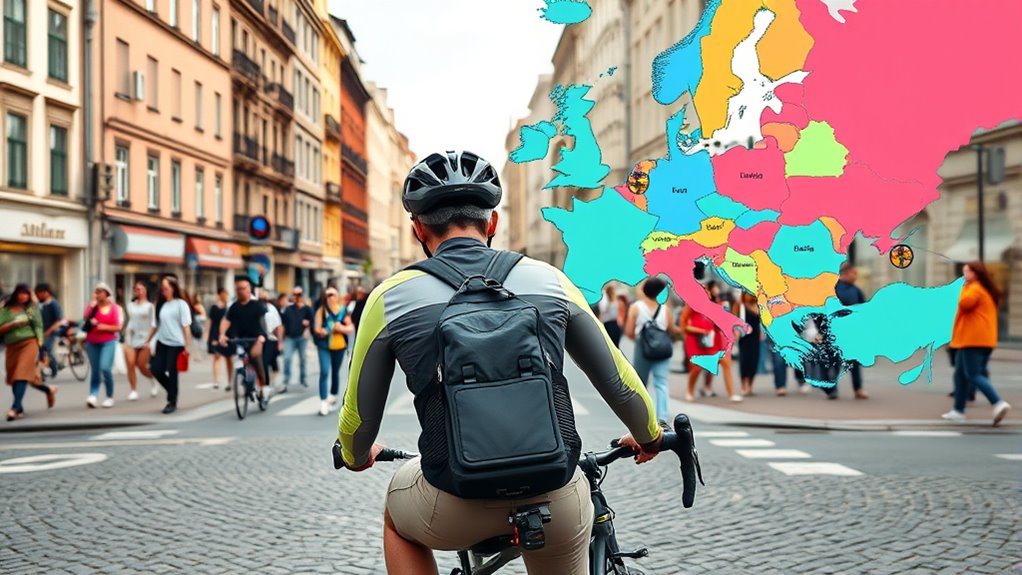
European countries each have their own specific rules for e-bike riders, resulting in a patchwork of laws you need to navigate. Here are some key differences:
- Germany considers e-bikes with assistance up to 25 km/h as bicycles, no license needed, but speed pedelecs above that require registration, insurance, and a license.
- The Netherlands treats standard e-bikes as bicycles and requires no registration, but speed pedelecs need a moped license and helmet.
- Italy mandates helmets for riders under 18 and requires registration, licensing, and a minimum rider age of 14 for high-speed S-pedelecs.
- France enforces helmet rules for riders under 12 and mandates registration and insurance for speed pedelecs over 25 km/h.
Licensing, Registration, and Insurance Requirements for E-Bikes
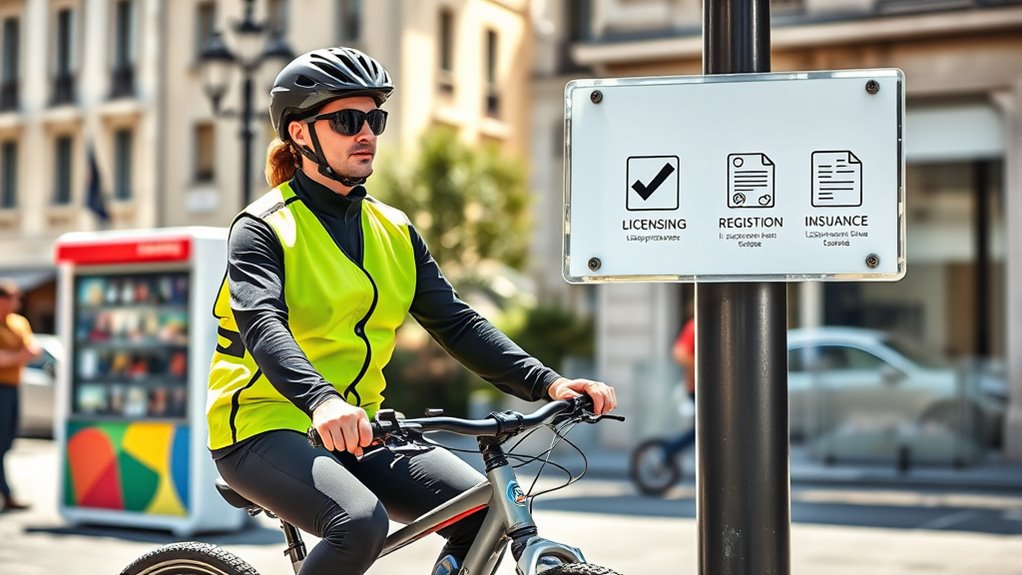
You should know that licensing, registration, and insurance rules for e-bikes vary depending on the type and speed. While most standard e-bikes don’t require registration or insurance, higher-powered models often do. It’s important to understand the specific requirements in your country to ride legally and safely. Additionally, understanding color accuracy can enhance your cultural knowledge and enjoyment, especially if you are interested in diverse storytelling styles.
Licensing by E-Bike Type
How you ride your e-bike in Europe depends largely on its type and speed capabilities. If you have a pedelec, which assists up to 25 km/h with a motor no more than 250W, you typically don’t need licensing, registration, or insurance. However, for a speed pedelec, capable of reaching 45 km/h with motors up to 4000W, licensing, registration, and insurance are usually required, similar to mopeds. To ride these higher-powered bikes legally, you often need to be at least 16 years old and hold a license or permit. Keep in mind, motor power and speed limits directly influence licensing rules, and helmets are mandatory for speed pedelecs. Always check your country’s specific laws to ensure compliance.
Registration Necessities and Exceptions
Most standard pedelecs, which assist up to 25 km/h with a 250W motor, are treated like regular bicycles across many European countries, meaning you don’t need registration, licensing, or insurance. Their classification as bicycles exempts them from these legal requirements. However, for speed pedelecs—those assisting up to 45 km/h with motors up to 4000W—you generally need to register the vehicle, obtain insurance, and hold a valid license, depending on the country. Some nations, like Italy and France, require registration and insurance for S-pedelecs, often setting minimum rider ages at 14 or 16. Always check local laws, as registration and licensing rules vary based on classification and rider age, and may have specific exceptions for off-road or throttle-only e-bikes. Additionally, regulations governing e-bike use can differ significantly between regions, so staying informed is essential for legal riding. It is also important to consider safety equipment requirements, which may include helmets, lights, and reflectors, depending on local regulations. Furthermore, awareness of e-bike classifications helps riders understand their legal obligations and proper use in different settings.
Insurance Regulations Across Countries
Across Europe, insurance requirements for e-bikes vary considerably depending on the model’s power and speed capabilities. You’ll find that standard e-bikes (pedelecs) often don’t need insurance, but higher-powered speed pedelecs usually do. Here’s what you should know:
- Speed pedelecs often require registration, licensing, and insurance before hitting the road.
- Countries like Germany, the Netherlands, and France make insurance compulsory for S-pedelecs and bikes over 250W or 25 km/h assistance.
- The UK mandates insurance for high-powered e-bikes, with non-compliant bikes classified as mopeds needing registration and insurance.
- Insurance policies typically cover theft, damage, and liability, aligning with legal requirements for more powerful models.
Age Restrictions and Rider Eligibility in Different Nations
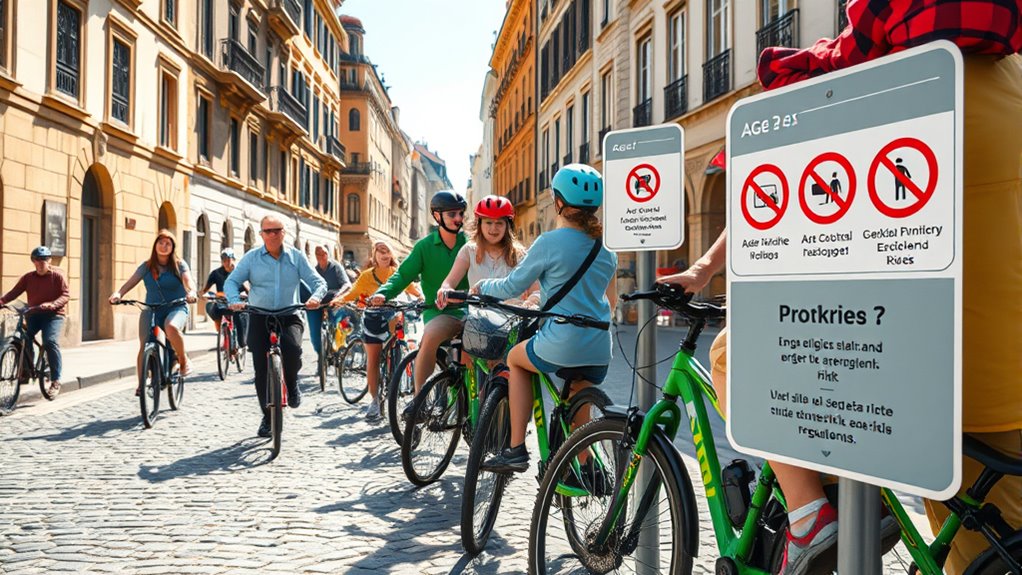
Age restrictions for riding e-bikes vary considerably from one European country to another, shaping who can legally operate different e-bike categories. In most European countries, the minimum age for standard e-bikes (pedelecs) is typically 14, though some nations allow riders as young as 12 for certain models. Speed pedelecs, which can reach higher speeds, often require riders to be at least 16 or 18 years old, with licensing and parental consent sometimes necessary. These laws reflect regional differences in rider eligibility and e-bike laws.
| Country | Minimum Age | E-bike Type | Licensing Needed | Comments |
|---|---|---|---|---|
| Italy | 14 | All e-bikes | No | Capable of 45 km/h |
| Germany | 14 | Pedelecs | No | Speed pedelecs require license |
| France | 12 | Pedelecs | No | Some restrictions apply |
| Spain | 14 | Speed pedelecs | Yes | Parental consent needed |
| Netherlands | 16 | Speed pedelecs | Yes | Higher speed limit |
Helmet Laws and Safety Guidelines for E-Bike Riders
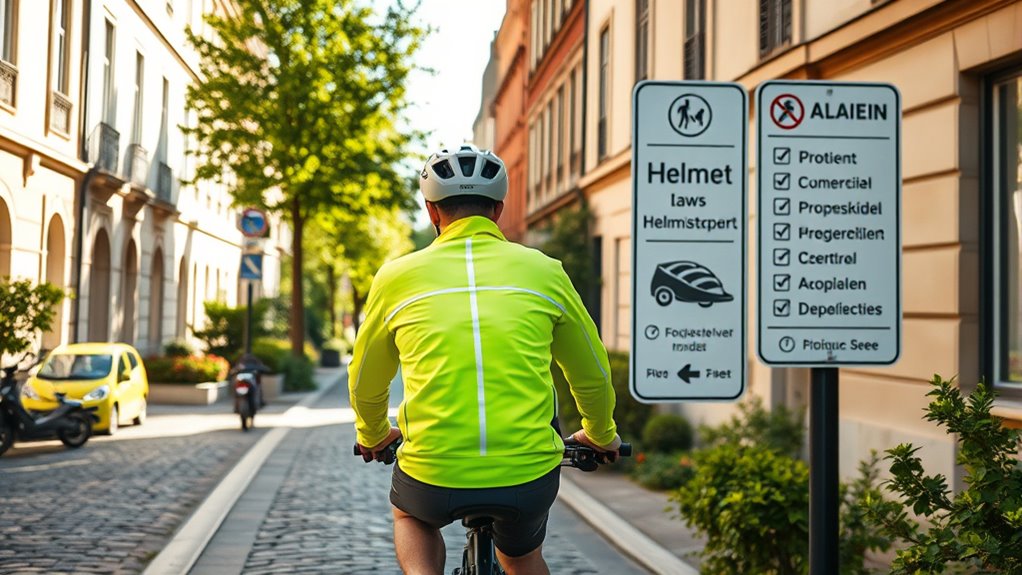
Have you ever wondered how helmet laws vary across Europe for e-bike riders? The safety regulations differ widely, so it’s essential to stay informed. Here’s what you need to know:
- Helmet use is mandatory for speed pedelecs (over 25 km/h) in countries like Germany, the Netherlands, and Italy.
- For standard e-bikes, helmet laws are often recommendations rather than requirements, especially for riders over 14 or 16.
- Countries such as France and Spain require helmets for all riders on interurban roads and certain age groups, emphasizing safety.
- Minors under 12 or 18 generally must wear helmets, with regulations varying by country and e-bike category.
Wearing a helmet markedly reduces head injury risks, making it a vital safety measure, whether legally mandated or not.
Permitted Usage Areas and Infrastructure Regulations
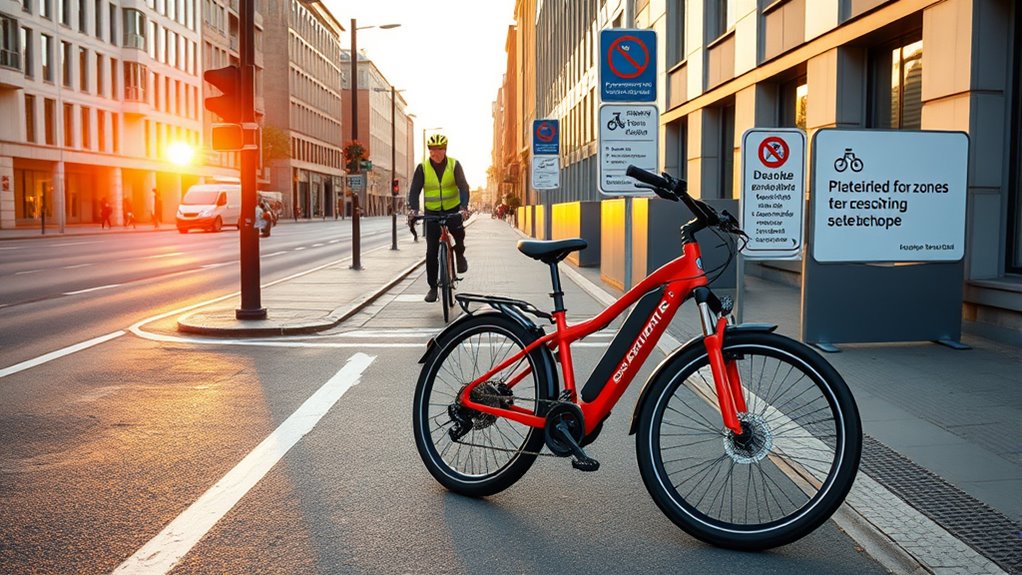
European regulations generally allow e-bikes on dedicated bike lanes and cycling paths, as long as they meet specific speed restrictions and power limits. You can ride your e-bike on dedicated cycling infrastructure, including bike lanes and cycling paths, without concern, provided you comply with local rules. Speed restrictions usually limit assistance to 25 km/h, and bikes exceeding this or with higher motor power may need registration and are often restricted to road use. Some regions permit e-bikes in shared zones or on pavements, but regulations vary across countries. Always check local infrastructure regulations to verify you’re riding legally. Remember, many areas restrict e-bikes with high assistance levels to roads, so staying informed about permitted usage areas helps you avoid penalties and ride safely.
Compliance and Certification for E-Bike Manufacturers and Models
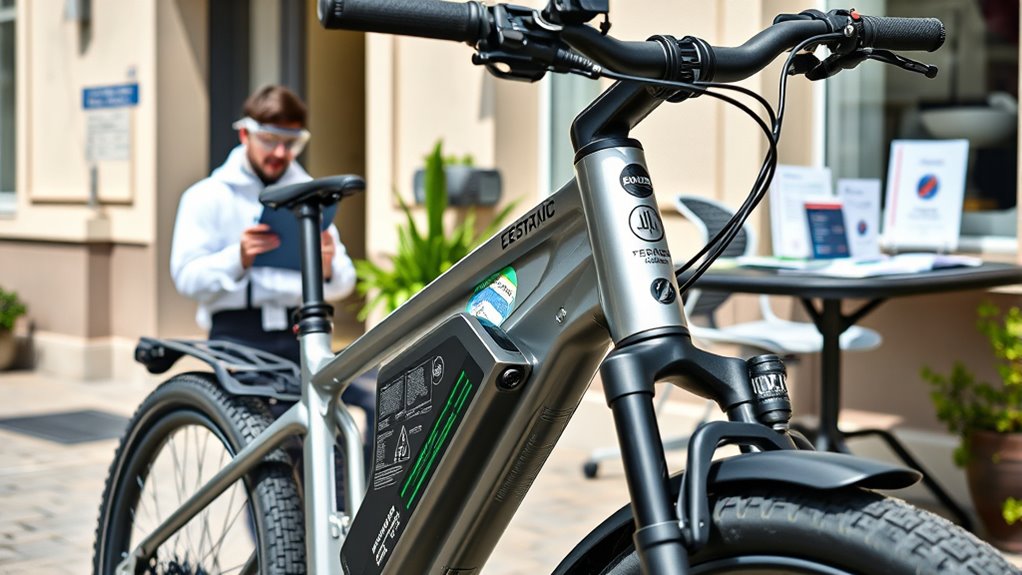
To ride legally across different regions, e-bike manufacturers must guarantee their models meet specific certification standards. Compliance with EU standards, like EN15194, is essential, limiting motor power to 250W and assistance to 25 km/h. Certification can be achieved through self-declaration or third-party conformity assessments to meet regulations such as the Machinery Directive and EU Regulation No 168/2013. Speed pedelecs over these limits require homologation and type approval before market entry. To ensure your e-bike is legal, pay attention to:
- Clear labeling of motor power and assistance speed
- Certification matching EU standards
- Conformity assessment procedures
- Ongoing compliance with evolving regulations
Staying compliant guarantees your e-bike remains legal and safe on European roads.
Penalties and Enforcement for Non-Compliance
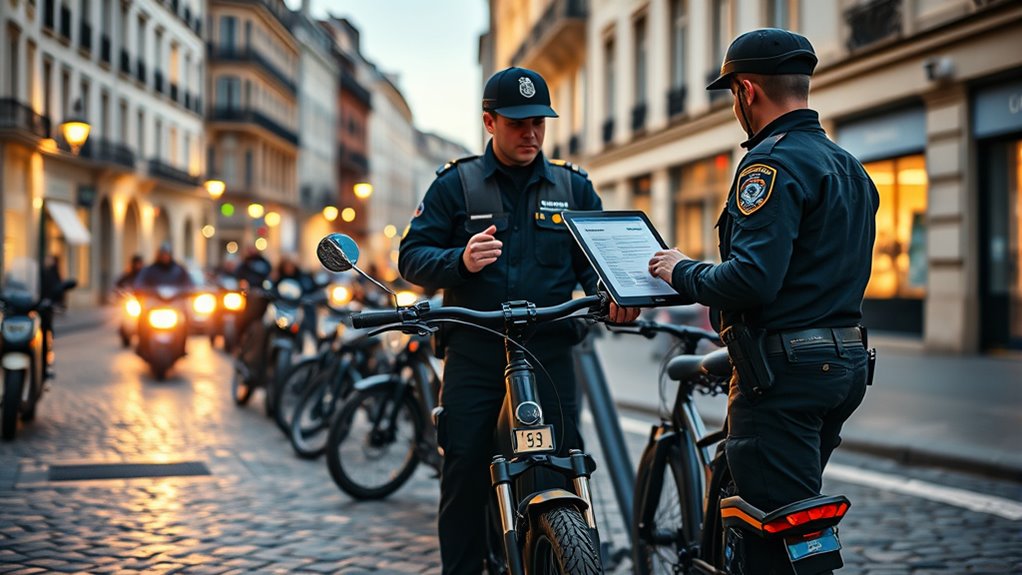
If you ride an e-bike that doesn’t meet legal standards, you could face hefty fines or even vehicle confiscation. Law enforcement regularly conducts checks, and penalties can include points on your license or criminal charges. Staying compliant helps you avoid these costly consequences and keeps your ride legal.
Fines for Violations
Violating e-bike regulations in Europe can lead to fines that range from €50 to over €1,000, depending on the specific offense and country. You might face penalties for various violations, such as exceeding speed limits, riding illegal e-bikes, or neglecting safety gear requirements. Enforcement agencies actively monitor compliance, and authorities can confiscate illegal e-bikes or impose re-registration. Here’s what you should watch out for:
- Fines for riding without proper safety gear like helmets for speed pedelecs.
- Penalties for exceeding speed limits or operating non-compliant bikes.
- Enforcement actions against illegal e-bikes and unregistered models.
- Increased fines or license suspensions for repeated violations or operating in restricted zones.
Stay compliant to avoid hefty fines and enforcement actions.
Law Enforcement Checks
Law enforcement agencies across Europe actively monitor e-bike usage to guarantee riders comply with power, speed, and registration regulations. They conduct enforcement checks using tools like speed guns, power measurement devices, and registration databases to identify violations. If you’re caught operating an unregistered e-bike or exceeding speed limits, you face penalties such as hefty fines, confiscation, or even criminal charges in some countries. Enforcement officers also verify compliance with licensing and insurance requirements. Repeated violations or riding unregistered e-bikes in restricted areas can lead to increased sanctions, including points on your license or bans from public roads. These enforcement efforts aim to uphold regulation adherence and ensure safe, legal riding across the continent.
Penalty Points System
European countries employ penalty points systems to enforce e-bike regulations, assigning demerit points for violations such as speeding or riding without proper safety gear. If you accumulate too many penalty points—often 12 or more—you risk license suspension or fines. Enforcement agencies actively monitor compliance through roadside checks, targeting violations like exceeding speed limits or illegal use of speed pedelecs on bike paths. Here are key points to contemplate:
- Penalty points add up for violations like ignoring safety gear rules or speeding.
- Enforcement includes regular roadside checks to catch infractions.
- Accumulating points can lead to license suspension.
- Fines are imposed immediately for infractions like riding without a helmet or breaking speed limits.
Staying compliant helps you avoid penalties and keeps your ride safe and legal.
Practical Tips for Ensuring Legal and Safe E-Bike Riding in Europe

To ride your e-bike legally and safely across different regions, it’s essential to stay informed about local regulations and follow best practices. Always verify the maximum motor power (usually 250W in the EU) and adherence to the speed limit (typically 25 km/h). Wear safety gear, including a helmet if required by law or for added protection, especially on faster e-bikes like speed pedelecs. Use designated bike paths when available, and avoid riding on sidewalks to prevent accidents and legal issues. Keep your e-bike properly registered and insured, carrying any necessary documentation. Regularly review local laws before riding in new areas, as rules can vary considerably. Staying compliant helps ensure your safety and a trouble-free riding experience across Europe.
Frequently Asked Questions
What Are the Rules for European E-Bikes?
You want to know the rules for riding e-bikes in Europe. Generally, if you ride a pedelec, it must have a 250W motor and assist up to 25 km/h, with no throttle. Speed pedelecs can go faster, up to 45 km/h, but often require registration, insurance, and a license. Helmets are mandatory for certain categories, especially for speed pedelecs and young riders. Always check specific country regulations before riding.
Do You Need a License for an Electric E-Bike?
You might think you need a license for every e-bike, but that’s not always true. For standard pedelecs helping up to 25 km/h with 250W motors, you usually don’t need a license in most European countries. However, if your e-bike exceeds those limits—like reaching 45 km/h or having higher wattage—you’ll likely need a license, registration, and insurance. Always check your country’s specific rules before riding.
Is a 750W Electric Bike Legal in the UK?
A 750W electric bike isn’t legal to ride in the UK without proper registration and licensing. Since it exceeds the 250W limit for EAPCs, it’s classified as a moped. You need to register it with the DVLA, insure it, and hold a suitable license, like a moped license. Riding it without these requirements is illegal and could lead to penalties. Always check the current laws before riding.
What Are the Laws Around Ebikes?
You’re wondering about the laws around e-bikes. In Europe, most e-bikes must have a motor power of 250W and assist only up to 25 km/h to be considered bicycles. You usually need to be at least 14 years old, and helmets are often mandatory, especially for speed pedelecs. Bikes exceeding these limits may be classified as mopeds or motorcycles, requiring registration, insurance, and licensing.
Conclusion
Exploring Europe’s e-bike laws is like steering through a vast, changing landscape—you must stay informed and adaptable. By understanding the classifications, regulations, and safety requirements, you’ll keep your journey smooth and legal. Think of these rules as the compass guiding your adventure, ensuring you enjoy the ride without hitting legal bumps along the way. Embrace the knowledge, stay compliant, and let your e-bike open new horizons on your European journeys.





